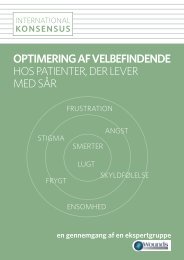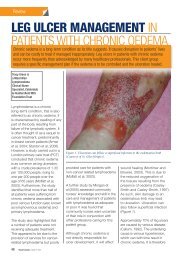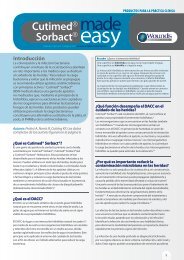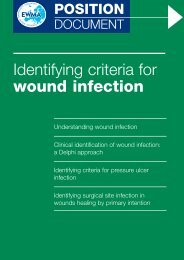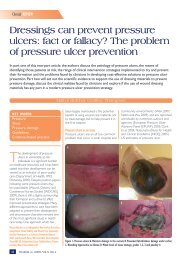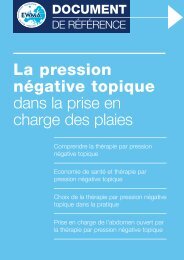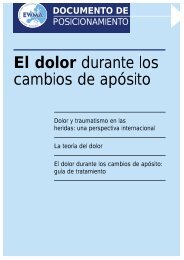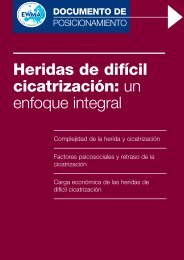VIEW PDF - Wounds UK
VIEW PDF - Wounds UK
VIEW PDF - Wounds UK
Create successful ePaper yourself
Turn your PDF publications into a flip-book with our unique Google optimized e-Paper software.
Pain intensity(0=none, 1=mild, 2=moderate, 3=severe)Clinical RESEARCH/AUDITwith some evidence of granulationtissue. Exudate levels were minimal, witherythema, oedema, eczema and drynessto the surrounding skin.A SF-MPQ was completed toassess his ulcer pain, and it was evidentfrom Mr L’s comments that this wasseverely affecting his quality of life. Hedescribed how the pain disturbed hissleep, and how his mobility was affectedas he was unable to put his foot fullyflat on the floor. His pain was poorlycontrolled with his current analgesia andhe described it as ‘feeling like a knife’.Mr L had been experiencing high painlevels in the ulcer since its recurrencefive months previously, and in previousulcerations over several years to thesame site. He had to rely on his wife forassistance with his daily activities andwith changing his dressings.Treatment outcomeMr L continued with his currenttreatment for a further week, at the endof which he stated that the pain wasstill affecting his mobility, describing it as‘biting, stinging and stabbing’. ActiformCool was applied along with modifiedcompression, with emollients and a mildsteroid ointment to treat eczema to thesurrounding skin.After two weeks, Mr L’s pain levelshad much improved. Figures 1 and 2indicate the changes in pain descriptorsand VAS scores recorded pre- andpost-Actiform Cool. Mr L requestedto continue with Actiform Cool as hisprimary dressing. Increased granulationtissue and more active wound edgeswere also observed in the ulcer itself,with a decrease in length to 8.1cm.However, as Mr L had been commencedon modified compression at the sametime as the Actiform Cool, these effectscould be attributed to the combinationof treatment, and not just the ActiformCool in isolation.Case study 2Clinical scenarioMrs C was a 71-year-old woman witha 10-year history of venous ulcerationto the left medial malleolus. Her onlymedication was regular co-codamol forulcer-related pain.Pre-Actiform CoolFigure 3. Changes in the VAS score pre and post-Actiform Cool in case study 2.ThrobbingShootingPre-Actiform CoolSharpCrampingGnawingHot-burningAchingClinical presentationMrs C presented to clinic with a painfululcer with a sloughy wound bed, minimalgranulation tissue and static woundedges. The ulcer measured 1.3 x 1.5cmwith a depth of 0.1cm. Exudate wasminimal, with erythema, dryness andeczema noted on the surrounding skin.The nature and intensity of the painexperienced by Mrs C was assessedusing the SF-MPQ, and she reportedthat ulcer pain disrupted her sleeppattern and mobility. She was unable togo out shopping on her own, despiteher analgesia. Dressing her woundand performing interventions wasdifficult due to the levels of pain sheexperienced.Post-Actiform CoolHeavyPain descriptorsPost-Actiform CoolTenderSplittingTiringFigure 4. Change in SF-MPQ Results Pre- and Post-Actiform Cool in case study 2.SickeningFearfulPunishing/cruelTreatment outcomeMrs C’s identified problem wasconstant severe pain in her ulcer whichadversely affected her sleep, mobilityand overall general well-being. She wascommenced on Actiform Cool dressingsand continued with her current Class IIcompression hosiery.When attending a community clinictwo weeks after commencing ActiformCool, Mrs C was experiencing less ulcerpain and only required analgesia to goto bed. She felt a lot brighter in herself,was sleeping better and stated it was the‘best week I’ve had in years’.After a further two weeks, MrsC was reviewed in the specialistI did this Pcool againIt was Pos<strong>Wounds</strong> <strong>UK</strong>, 2008, Vol 4, No 327




